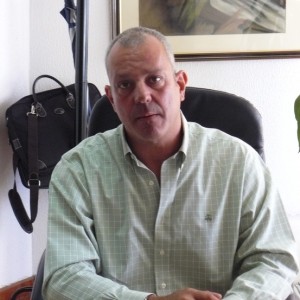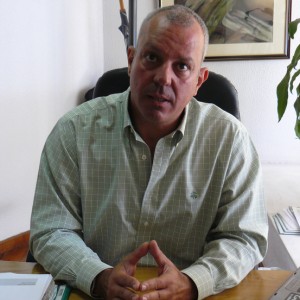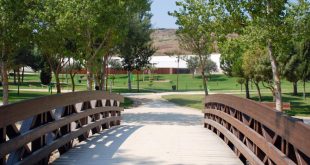Miguel Fragoso (mechanical engineer) began his career in the maintenance and mechanical department in 1987 at Rodoviária Nacional (RN (National Coaches)) servicing the Algarve fleet of what was then RN. In 1989, he took over another company in the Barraqueiro group. Today, the group is made up of four companies and including EVA and Frota Azul Algarve.
ECO123: How did you get to work today?
Miguel Fragoso: By car because I live in Vilamoura and my role in the company forces me to travel around and that means I cannot avoid giving up on a personal vehicle due its availability and the speed of transport.
Is there a bus service between Vilamoura and Faro?
There is. The problem derives more on availability should I have to make a quick trip to a particular place to be available and this means that, as I don’t have a 9 to 5 kind of job, it’s difficulty to coordinate timetables with this need for availability and getting around the region.
How many buses does the group currently have?
In the Algarve, we have around 600 buses and 850 members of staff.
How many passengers do you carry daily?
We have around 25,000 passengers using public transport daily.
Out of the 400,000 who live in the region?
Not necessarily – a percentage of our passengers don’t live here. Those who visit us and use public transport. There is a better prepared international culture tailored to using public transport more than that of the Portuguese. When referring to utilisation rates, we’re talking about trips and any passenger might make two or three trips per day.
What is the vehicle occupancy rate?
We have morning and afternoon peaks with an average occupancy rate of around 70%. In overall terms, we have an occupancy rate of 20%. That is very low for a private company without any type of state support, living off its passenger and ticket revenues.
So, eight out of every ten places are empty!
The problem is that in Portugal, on the one hand, we have only very slowly become culturally prepared to use public transport. On the other hand, there have been substantial changes over the last decade with the setting up of urban transport networks in various different cities and leading to a very different transport dynamic to that existing beforehand.
Can you give us an idea about how many litres of fuel your 600 buses consume daily?
We have buses of different sizes but the average level of fuel consumption is 32 litres per 100 km.

How many kilometres does each vehicle do on average?
That depends. An inter-urban service vehicle does around 80,000 km per year. However, an Expresso coach running between Lisbon and the Algarve, for example, does 220,000 km per year. We get through around 60 tons of fuel per week, thus, 60,000 litres.
In any road transport company, the two main costs are fuel and personnel. Our efforts have focused on the acquisition of more economic vehicles with lower levels of consumption and pollution. Quite simply, it’s not easy coping with the fall in demand for public transport and the lack of joint policies enabling mobility and effectively fostering people switching from individual to public transport. This makes renewing the fleet in the way we would like to a highly complicated business.
How many of your 600 vehicles are electric-powered?
We’ve got one electric vehicle. Effectively speaking, the technology available at this moment for public transport vehicles contains certain limitations. One is cost. An electric vehicle costs around 50% more than a diesel vehicle with a EURO6 motor that returns a very good pollution performance. Furthermore, as we live in the Algarve, we have to have air conditioning that raises consumption whether of diesel or of electricity. With this electric vehicle, we have already done tests here inside the city and we have not achieved over 100km in terms of autonomy. For public transport, that is very low.
Why do you think citizens prefer travelling in their own car than catching public transport?
Information takes a while to reach people. A great majority lack the information about the range of public transport services. Furthermore…
…perhaps a different marketing strategy might be a better approach?
We have made an effort and promoted our timetables across the most diverse institutions in the cities. Unfortunately, much of this gets stolen or vandalised. We have a Facebook page linked to our own site set up to get closer to our various users and become more interactive. However, there is a problem that proves even more complicated! I cannot possibly invite citizens to travel between Faro and Olhão when it takes longer on public transport than in their own car! There are policies that are simply not interconnected in terms of mobility. There is a stated desire to boost citizen mobility on the one hand – but, on the other, we reach the conclusion that in practice we still lack the access infrastructures. Take, for example, the relaying of the 125 highway. There were significant improvements but I still don’t see any purpose dedicated BUS lane. Albufeira to Faro is an interesting route not only for the region’s own people but also for students and tourists.
…which means that public transport gets stuck in traffic jams on 125 for hours?
For hours. They end up at the same speed as personal transport with public transport also getting caught up in the same congestion and having to stop.
Do we live in an egoistic society?
No, I don’t think we live in an egoistic society but I do consider society has unfortunately lagged in its planning. Urban planning. This is undertaken locally but there is no regional level planning. We cannot continue to perceive the Algarve as individual cities. And that is not only in terms of the operator and ensuring better standards of ease and comfort. When time is money and the time taken to complete the trip is high in terms of what people need. Therefore, individual transport wins. Indeed, whenever we lose a person to their personal transport, we never get them back again.
How much does a trip from Faro to Porto with your company?
We don’t have any direct services to Porto. That means that anybody going north of Lisbon has to catch two different coaches and using the connection in Lisbon to travel on to Porto. But this costs around 35 Euros. We do Faro from Lisbon and then from Lisbon to Port in five hours and forty minutes. Effectively, that is the real cost of the service.
Why does flying prove cheaper than travelling by train or coach?
Relative to the low-cost operators and very objectively, I think that we all have to take care of ourselves! And do our own sums. Personally, given the airport charges that are currently in effect and with the ecological footprint tending to ensure they have to rise, I think that that is an unreal transport cost.
If I want to catch the bus at the weekend between Vila Real St° António and Alcoutim, there’s no service. Do people complain that the only service runs between Monday and Friday? And even that’s only one bus in the morning and another in the afternoon.
There are many parts of the country where, effectively speaking, the range of public transport services, and especially in winter because the situation is a little better during the summer, in winter on Saturdays as from 2pm and on Sundays and on public holidays there is simply not enough passenger traffic to justify running a public transport service. At least not yet.
Do we need smaller vehicles with fewer seats?
The plans do take that into consideration and are still on the table. This solution is already in effect in some parts of the Algarve. However, the major problem is that the company invests in solutions and then ends up facing competition on behalf of the municipalities. There are various different Municipal Councils that run their own transport services and do so freely and on top of our own routes.
The ticket from Monchique to Portimão costs €4.30 for 25km. That means a return trip is €8.60. A person who works and takes public transport thus spends €89 every month. For somebody taking home €700 monthly, is that not a major cost?
That is very expensive. And we only launched the pre-purchased ticket a short while ago. A set of tickets or a travel pass does cut the cost of the daily ticket even if remaining expensive.
Are there any solutions?
Public transport tariffs in Portugal are defined by the regulatory authority for the transport sector, the IMT. And this works in accordance with the kilometre based table for each respective concession. Now, all of this proves possible…
 Are you able to sell me a monthly travel pass for the Algarve region?
Are you able to sell me a monthly travel pass for the Algarve region?
Currently, we, the operators, have launched similar tickets but not yet monthly unfortunately. However, we do have a product that we call a tourism pass and not exclusive to tourists. Passengers can use this in both tourism and non-tourism regions throughout three or seven days. For a single ticket, you can use either Frota Azul or EVA Transportes, one of the synergies we have created.
How much does this cost?
Around €35 for seven days.
So that’s €140 per month.
If you add it up that way, yes.
And to Lisbon?
No. That is a different service based upon legislation with other types of requirements.
What scope is there for cooperation between the Group and Portugal Railways?
There is scope for interconnecting timetables! Let me give you an example. When setting up an urban transport network, special attention goes to timetables and spatial coverage and the way in which they link up with the railway service. This refers specifically to Faro and Portimão where whoever comes out of the railway station almost automatically gets onto the bus network. This is a major advantage and we have been paying attention to this.
A car costs between five and six thousand euros per year to run. Would it be feasible to launch an annual ticket for buses and trains for half that price?
That’s a very interesting question! However, the issue is beyond our competence as operators can propose the ticket but that would still require state regulation.
Furthermore: isn’t mobility a right? Could a transport public service be provided?
It is. However, that concept has not been duly internalised by the regulatory authority. That falls within the scope of regulation and should and will have to find appropriate ways as alterations to automobile transport regulation are already under discussion as the legislation dates back to 1948 and is practically pre-historic. We operators are working daily based on these 1948 regulations and there has clearly since been a set of transport dynamics and needs that have changed in the meanwhile and yet the legislation remains the same.
We perhaps should at least consider indexing the price paid for transport to the salary a person earns?
The objective intended and what does exist is that referred to as the social pass. This social pass is currently only valid in the metropolitan areas of Porto and Lisbon. The objective of this government involves expanding this social pass nationwide as everybody has the right to mobility. It makes no sense to set up a social pass just for the metropolitan areas of Lisbon and Porto when Portugal extends far further.
And how about putting a tax on aviation fuel that currently remains exempt?
They transfer the ecological charges to the airport rates and the fuel should be taxed. However, it isn’t. For example, another aspect relates to car parking meter revenues that should revert to the public transport system but, with rare exceptions, that does not exist. The local property tax, for example, is in the hands of local council presidents and they could say that they are going to raise it to the maximum rate not out of any Troika stipulated obligation but because this 1% differential might be channelled into establishing effective mobility for their local populations and setting up a transport network for operators. Thus, setting up means of actually financing public transport. However, nobody wants to pay this social cost! That’s the real problem. And it’s not down to the operator to bear those costs without any form of state support.
 We can do better.
We can do better.
We need tools. Firstly, we need the political will. We’re not about to say that public transport is very good! And that everybody should use it! But we’ve got the 20-20 rule on the way whereby we have to reduce our emissions by 20% by 2020. Kyoto. We have to have the political will with the public entities really deciding: just what do we really want?
With reference to the Algarve’s municipalities, they’ve got 85 coaches in total and provide free services very often in parallel to our concessions. Monchique is one example. They say they’re only transporting elderly persons but they don’t only carry this age group. We know this. Now, you tell me, just what is the operator’s interest in running a line with a low level of demand and then also encountering the municipality running its own buses in order to overcome, in its understanding, the social costs of transport. This is a vicious circle as I do not create more supply because I have no demand.
How do we break the circle? Where to start? How to reduce the waiting time between buses, trains, taxis, etcetera?
The first step is approaching public transport as a holistic network and not as individual pieces. This requires organisation and intelligence with information enabling us to switch from one means of transport to another across all the means available. However, as stated, planning has been very slow. The electoral cycles in Portugal, especially local government, are very short.
Solutions!
In the Algarve, we have a Municipal Association that approaches all of the problems shared by municipalities and reaches single, joint solutions. This forum works in a logical and intelligent fashion and brings all actors to the table to reach joint solutions. This reaches beyond solutions for just Faro or Portimão.
This seeks to establish a global and interactive public transport policy. Now, we are discussing the real inputs from commissions, study groups and similar as Portugal is overflowing with such bodies.
Finally, does EVA make a profit?
IVA is current in a break even phase, so…
…so EVA made a loss last year?
Not a loss thankfully. We report consolidated results as the company in the Algarve runs four subsidiaries, some support the others and just as well. If there weren’t these synergies, some of the companies would already have gone under and entered bankruptcy.
What was the 2013 result?
I don’t have the 2013 result at this moment. In all the Algarve, around a million euros.
Subsidies?
Zero.
Thank you for talking to us.
 Eco123 Revista da Economia e Ecologia
Eco123 Revista da Economia e Ecologia



